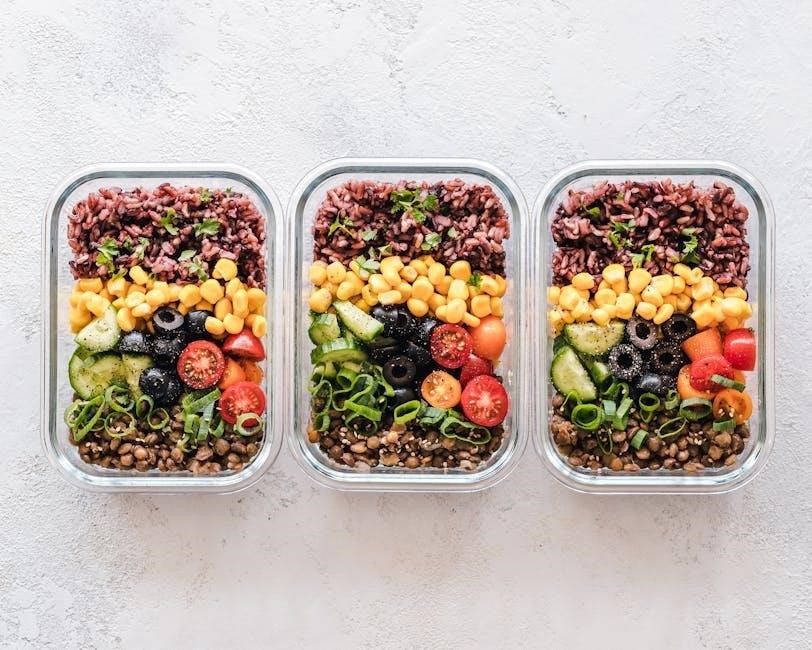A well-structured lupus diet plan, available as a downloadable PDF, offers a comprehensive guide to managing symptoms through nutrition. It includes meal plans, recipes, and expert advice to reduce inflammation and promote overall well-being.

1.1 Understanding the Importance of Diet in Lupus Management
Diet plays a crucial role in managing lupus symptoms and improving overall well-being. A balanced diet helps reduce inflammation, supports immune health, and enhances energy levels. The lupus diet plan PDF emphasizes the importance of nutrient-dense foods, such as fruits, vegetables, whole grains, and lean proteins, while avoiding triggers like processed foods and red meat. By adhering to a well-structured meal plan, individuals with lupus can better control their condition and improve their quality of life. This approach not only aids in symptom management but also promotes long-term health and resilience.
1.2 Overview of the Lupus Diet Plan PDF
The lupus diet plan PDF is a comprehensive guide designed to help individuals manage their condition through nutrition. It includes a 4-week Mediterranean-style meal plan with daily recipes, portion sizes, and nutritional advice. The PDF also features shopping lists, prep guides, and tips for adapting the plan to personal preferences. This structured resource aims to reduce inflammation, promote healing, and provide essential nutrients for overall health. By following the lupus diet plan PDF, individuals can gain control over their symptoms and improve their quality of life with practical, easy-to-follow guidance.
Key Principles of the Lupus Diet
The lupus diet focuses on reducing inflammation, avoiding trigger foods, and promoting balanced nutrition to support immune health and overall well-being through tailored dietary strategies.

2.1 Anti-Inflammatory Foods
Anti-inflammatory foods are central to the lupus diet, helping reduce inflammation and alleviate symptoms. These include fruits, vegetables, whole grains, lean proteins, and omega-3 rich foods like fatty fish. Berries, leafy greens, and nuts are particularly beneficial due to their high antioxidant content. Incorporating these foods supports immune function and overall health, making them essential for managing lupus effectively.

2.2 Balanced Nutrition for Immune Health
A balanced diet is crucial for maintaining immune health in lupus patients. It ensures the body receives essential nutrients like vitamins, minerals, and antioxidants. Incorporating a variety of colorful vegetables, fruits, whole grains, lean proteins, and healthy fats supports immune function. The DASH Eating Plan, high in vegetables, fruits, and whole grains, is often recommended. This approach helps regulate inflammation and promotes overall well-being, making it a cornerstone of the lupus diet plan PDF for managing symptoms effectively.
2.3 Avoiding Trigger Foods
Avoiding trigger foods is essential to manage lupus symptoms. Processed foods, high-sodium items, sugary and refined carbohydrates, red meat, and saturated fats can exacerbate inflammation. Alcohol and caffeine should also be limited, as they may trigger flares. Eliminating these foods helps reduce inflammation and supports immune balance. The lupus diet plan PDF provides detailed lists of foods to avoid, ensuring a clear guide for making healthier choices. By focusing on nutrient-dense options and avoiding triggers, individuals can better control their condition and improve overall well-being.

Foods to Include in the Lupus Diet
The lupus diet plan PDF emphasizes anti-inflammatory foods like fruits, vegetables, whole grains, lean proteins, and omega-3 rich foods. These support immune health and reduce inflammation.
3.1 Anti-Inflammatory Fruits and Vegetables
Fresh berries, leafy greens, and cruciferous vegetables are key in reducing inflammation. These foods are rich in antioxidants and fiber, supporting immune health. The lupus diet plan PDF highlights their role in managing symptoms and suggests incorporating them into daily meals for optimal benefits.

3.2 Whole Grains and Fiber-Rich Foods

Whole grains and fiber-rich foods are essential for reducing inflammation and improving digestive health. The lupus diet plan PDF emphasizes incorporating quinoa, brown rice, oats, and barley, which are rich in nutrients and fiber. These foods help regulate blood sugar levels and support immune function. Including fiber-rich options like legumes, lentils, and whole grain bread can also reduce fatigue and promote overall well-being. The plan encourages substituting refined carbohydrates with whole grains to enhance nutritional intake and manage lupus symptoms effectively.
3.3 Lean Proteins and Omega-3 Rich Foods
Lean proteins and omega-3 rich foods play a crucial role in reducing inflammation and supporting immune health. The lupus diet plan PDF recommends incorporating fatty fish like salmon, mackerel, and sardines, which are rich in omega-3 fatty acids. Plant-based options such as flaxseeds, chia seeds, and walnuts are also excellent sources of omega-3s. These foods help combat inflammation and promote healing. Including lean proteins like poultry, tofu, and legumes ensures adequate nutrition without triggering flare-ups. The plan emphasizes balancing protein intake with omega-3 sources to support overall health and manage lupus symptoms effectively.
3.4 Herbs and Spices with Anti-Inflammatory Properties
Herbs and spices with anti-inflammatory properties are essential in the lupus diet plan PDF. Turmeric, ginger, and garlic are highly recommended for their potent anti-inflammatory effects. Turmeric contains curcumin, which helps reduce inflammation and improve symptoms. Ginger has natural anti-inflammatory compounds that aid in pain relief. Garlic supports immune health and reduces inflammation. Cinnamon and basil are also beneficial for their anti-inflammatory and antioxidant properties. Incorporating these herbs and spices into meals enhances flavor while promoting healing and managing lupus symptoms effectively. The lupus diet plan PDF provides creative ways to use these ingredients in daily recipes.

Foods to Avoid
The lupus diet plan PDF advises avoiding processed foods, high-sodium, sugary carbs, red meat, saturated fats, alcohol, and caffeine to reduce inflammation and manage symptoms effectively.
4.1 Processed and High-Sodium Foods
Processed and high-sodium foods can exacerbate lupus symptoms by promoting inflammation and fluid retention. The lupus diet plan PDF recommends limiting these to reduce disease activity. Avoid packaged snacks, frozen meals, and canned goods, as they often contain excessive salt and preservatives. Opting for fresh, whole foods instead can help minimize inflammation and improve overall health. By eliminating high-sodium options, individuals with lupus can better manage their condition and reduce the risk of complications. The PDF provides clear guidelines on identifying and avoiding these harmful foods, making it easier to adopt a healthier diet.
4.2 Sugary and Refined Carbohydrates
Sugary and refined carbohydrates can trigger inflammation and energy fluctuations, worsening lupus symptoms. The lupus diet plan PDF advises minimizing these foods to reduce disease activity. Refined carbs, such as white bread and pastries, cause rapid spikes in blood sugar, which can exacerbate inflammation. Similarly, sugary snacks and drinks contribute to oxidative stress, further straining the immune system. By eliminating these from your diet, you can better manage symptoms and support overall health. The PDF provides practical tips for identifying and avoiding sugary, refined foods, helping you make healthier choices to alleviate lupus-related discomfort.
4.3 Red Meat and Saturated Fats
Red meat and saturated fats can increase inflammation, worsening lupus symptoms. The lupus diet plan PDF recommends reducing consumption of red meat and avoiding processed meats altogether. Saturated fats, often found in fatty cuts of beef and pork, can trigger inflammatory responses. Opting for leaner protein sources, such as poultry or fish, helps minimize inflammation. Additionally, the PDF suggests limiting dairy products high in saturated fats. By reducing these foods, individuals with lupus can better control inflammation and improve overall health outcomes. The guide provides clear guidelines to help make these dietary adjustments effectively.
4.4 Alcohol and Caffeine
Alcohol and caffeine can exacerbate lupus symptoms by triggering inflammation and dehydrating the body. The lupus diet plan PDF advises moderation or complete avoidance of these substances. Alcohol can interfere with medication effectiveness and worsen organ damage, while caffeine may increase anxiety and disrupt sleep patterns. Both can also impair the immune system, making it harder to manage the disease. The PDF recommends substituting these with herbal teas or water to stay hydrated and support overall health. By limiting alcohol and caffeine intake, individuals can better control their symptoms and improve their quality of life.
Meal Planning and Preparation
A structured guide, like the lupus diet plan PDF, offers a 4-week meal plan with recipes, shopping lists, and prep tips to simplify healthy eating and reduce inflammation.
5.1 Creating a 7-Day Meal Plan
The lupus diet plan PDF provides a structured 7-day meal plan, offering daily recipes and portion guidance. It incorporates anti-inflammatory foods, whole grains, and lean proteins, aligning with Mediterranean-style eating. Each day includes balanced breakfast, lunch, dinner, and snack options, ensuring variety and nutrient density. The plan emphasizes fresh vegetables, fruits, and omega-3 rich foods to reduce inflammation. Detailed shopping lists and prep tips make implementation easy. This approach helps manage lupus symptoms while promoting overall health and well-being through a sustainable and delicious dietary framework.
5.2 Preparing Healthy and Tasty Recipes
The lupus diet plan PDF offers easy-to-follow recipes that are both nutritious and flavorful. These dishes focus on anti-inflammatory ingredients like fresh vegetables, lean proteins, and whole grains. Each recipe includes step-by-step instructions and tips for meal prep, ensuring convenience. Herbs and spices add natural flavor without triggering inflammation. The PDF also provides variations to accommodate different tastes and dietary needs. By emphasizing nutrient-dense foods, these recipes help reduce inflammation and support immune health, making them a delicious and practical choice for managing lupus symptoms effectively.
5.3 Grocery Shopping Tips
Effective grocery shopping is key to following the lupus diet plan. Start with a structured list based on your meal plan to avoid impulse buys. Focus on fresh, whole foods like vegetables, fruits, and lean proteins. Opt for whole grains, nuts, and seeds, which are rich in fiber and nutrients. Avoid processed and high-sodium items by reading labels carefully. Shop the perimeter of the store, where healthier options are typically located. Incorporate anti-inflammatory herbs and spices to enhance flavor without triggering inflammation. Planning ahead ensures you stay on track and maintain a balanced diet tailored to your needs.
Lifestyle Considerations

Staying hydrated, regular exercise, and stress management are crucial lifestyle considerations that complement the lupus diet plan, enhancing overall well-being and symptom management effectively.
6.1 Staying Hydrated
Staying hydrated is essential for overall health, especially for those managing lupus. Drinking plenty of water helps reduce inflammation and supports kidney function. Aim for at least eight glasses daily. Herbal teas and fresh juices can also contribute to hydration. Avoid sugary drinks and caffeine, which can dehydrate the body. Incorporating water-rich foods like cucumbers and watermelon can further support hydration goals. Proper hydration not only aids in digestion but also helps maintain energy levels and skin health, making it a simple yet crucial part of the lupus diet plan.
6.2 Exercise and Physical Activity
Regular physical activity is a key component of managing lupus. Gentle exercises like walking, swimming, and yoga can reduce inflammation, improve heart health, and boost mood. Strength training and flexibility exercises also support overall well-being. It’s important to balance activity with rest to avoid overexertion, which can trigger flares. Consulting with a healthcare provider to create a personalized exercise plan is recommended. Consistency is key, as regular movement helps maintain energy levels and reduces stress. Incorporating physical activity into your daily routine, as outlined in the lupus diet plan PDF, can significantly enhance your overall health and symptom management.
6.3 Managing Stress
Stress management is crucial for lupus patients, as high stress levels can trigger flares. Techniques like meditation, deep breathing, and yoga can help reduce stress and improve overall well-being. Engaging in hobbies and setting realistic goals can also alleviate stress. It’s important to balance activity with rest to avoid burnout. The lupus diet plan PDF emphasizes the importance of incorporating stress-reducing activities into daily routines. By managing stress effectively, individuals with lupus can better control symptoms and maintain a healthier lifestyle; Regular relaxation practices and seeking support from loved ones or professionals can make a significant difference in managing stress.

The Science Behind the Lupus Diet
The lupus diet focuses on reducing inflammation and supporting immune health through nutrient-dense foods. It leverages scientific research to create a tailored eating plan that minimizes symptom triggers and promotes healing.
7.1 How Diet Impacts Inflammation
Diet plays a crucial role in managing inflammation in lupus. Anti-inflammatory foods like fruits, vegetables, and omega-3 rich options help reduce inflammation, while processed and high-sodium foods can worsen symptoms. The lupus diet plan PDF emphasizes nutrient-dense choices to minimize inflammation and support immune health, providing a structured approach to identifying beneficial and harmful foods. By focusing on whole, unprocessed foods, individuals can better control inflammation and improve overall well-being. The plan also highlights the importance of avoiding triggers that may exacerbate symptoms, offering a clear guide to making informed dietary decisions.
7;2 The Role of Nutrition in Immune Support
Nutrition is vital for immune support in lupus management. A diet rich in antioxidants, omega-3 fatty acids, and fiber helps regulate the immune system and reduce inflammation. The lupus diet plan PDF highlights the importance of whole foods, such as fruits, vegetables, and whole grains, which provide essential vitamins and minerals. Lean proteins and herbs with anti-inflammatory properties further support immune health. By focusing on nutrient-dense foods, individuals can strengthen their immune system and better manage lupus symptoms, ensuring a balanced and supportive dietary approach to overall well-being.
7.3 The Importance of Nutrient-Dense Foods
Nutrient-dense foods are essential for managing lupus, as they provide vital vitamins, minerals, and antioxidants that help reduce inflammation and support overall health. The lupus diet plan PDF emphasizes the inclusion of whole, unprocessed foods like leafy greens, berries, and fatty fish, which are rich in anti-inflammatory properties. These foods not only help alleviate symptoms but also promote long-term well-being. By focusing on nutrient-dense options, individuals can create a balanced diet that supports their immune system and reduces disease activity, making the lupus diet plan PDF a valuable resource for tailored nutrition.
The lupus diet plan PDF is a vital resource for managing symptoms and improving well-being. It offers structured guidance, recipes, and expert advice to help reduce inflammation and promote healing through nutrition.
8.1 Final Thoughts on the Lupus Diet Plan
The lupus diet plan is a powerful tool for managing symptoms and improving quality of life. By focusing on anti-inflammatory foods, balanced nutrition, and avoiding triggers, individuals can reduce inflammation and support immune health. The downloadable PDF provides a structured guide, including meal plans and recipes, to help individuals stay on track. Consistency is key, and adapting the plan to personal needs ensures long-term success. With the right dietary approach, many people with lupus can experience significant improvements in their symptoms and overall well-being. Encouraging a proactive approach to nutrition can make a meaningful difference in managing the condition effectively.
8.2 Encouragement to Download the Lupus Diet Plan PDF
Downloading the lupus diet plan PDF is a proactive step toward managing symptoms and improving overall health. This comprehensive guide offers structured meal plans, delicious recipes, and practical tips tailored to reduce inflammation and promote healing. With detailed shopping lists and prep guides, it simplifies the process of adopting a healthy diet. By following this plan, individuals can take control of their nutrition and make informed choices that support their well-being. Don’t miss this opportunity to transform your approach to managing lupus—download the PDF today and start your journey toward a healthier, symptom-free life.
